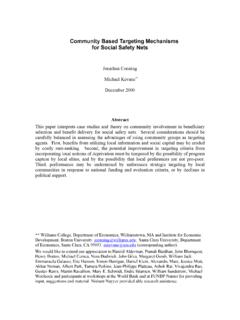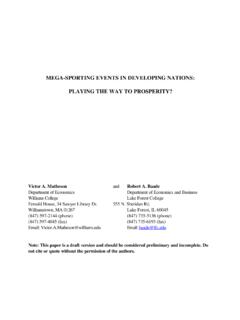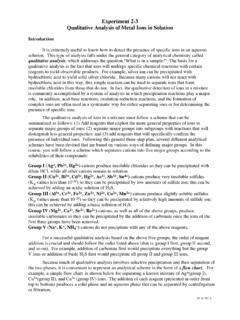Transcription of Why is Gentrification a Problem - Williams College
1 Why is Gentrification a Problem ? Stephen Sheppard Professor of Economics Williams College 1. Introduction Social and political concerns with Gentrification have waxed and waned since the term was first coined in 1964 to describe the movement of middle class families into the former working-class neighborhoods of London. Since the term Gentrification was first used, the phenomenon has been a source of debate for both scholars and policy makers in the US, Europe and elsewhere. Some authors have viewed it as a beneficial (or at worst neutral) undoing of the white flight abandonment of central city neighborhoods that took place in many cities during the period from the mid-1940s through the late 1960s.
2 Perhaps this Gentrification would return some wealth, tax base and a modicum of affluence to urban neighborhoods that had been hard hit by loss of businesses, jobs and tax-payers. Alternatively, Gentrification has been viewed (at a minimum) as an unfortunate desecration of interesting and authentic urban neighborhoods, a dilution of vibrant ethnic neighborhoods into something that is bland and uninteresting. At worst, the critics of Gentrification have viewed the phenomenon as a major source of disadvantage for low income urban residents who, having established a community with all of its complex social networks must now see it torn apart as they are displaced either by choice or compulsion to move to other housing that is less desirable or alternatively remain behind to pay higher rents in a neighborhood they no longer feel is their own.
3 One other perspective deserves separate mention. This is that Gentrification may or may not be unfortunate for the original or displaced residents, but that it is a natural or even organic part of urban development. Thus Brueckner and Rosenthal (2009) see Gentrification as a natural consequence of the process of ageing with a durable housing stock, and present a model that has Gentrification as a predicted outcome that can be expected to eventually take place in all cities. A related perspective might accept that Gentrification has adverse consequences, but that policies designed to prevent any Gentrification would be worse.
4 Such anti- Gentrification policies might encourage an urban environment in which economic classes or ethnic subgroups have particular neighborhoods to which they are entitled; and where one ethnic group is entitled others may be excluded. From this, it is feared, it is a short step to say that these are the neighborhoods to which they should be restricted. Recent history presents a variety of perspectives about who constitutes the gentrifiers and the displaced . In 1983, for example1, a proposal by then New York City mayor Ed Koch to build 117 apartments for artists in the lower east side of Manhattan was defeated after an acrimonious hearing by the city Board of Estimate.
5 One opponent called the proposal a scam .. that would gentrify a neighborhood with the young, the white and the rich. A supporter, a gallery owner in SoHo, defended the plan to use federal housing funds to build the units saying that .. artists, by their nature, are an integrated race of people. Almost three decades later, artists living in the area have been mostly pushed out of the neighborhood, and complain about being displaced by Gentrification . Much of the research that has been done concerning Gentrification has focused on whether Gentrification imposes particular harm on poor households, and whether these households are displaced into worse housing situations.
6 Thus Schill and Nathan (1983) conducted surveys of 1 See Carroll (1983) displaced residents from gentrifying neighborhoods in five different cities. They found that displaced residents did not live in worse conditions following their moves. The majority of the displaced reported increased levels of satisfaction with their home and neighborhood and commute times were more likely to decrease after the move. Subsequent careful research has continued to find only limited evidence that the displaced poor are disadvantaged relative to their previous housing arrangements, although this may depend on the particular urban context.
7 Atkinson (2000) found substantial displacement occurring in London, with most of the displacement among those employed in unskilled or semi-skilled occupations. In the US context, however, Freeman and Braconi (2004) presented data that suggested the poor are not differentially likely to be displaced, and Vigdor (2002) examined Boston data that suggested that while some displacement does take place the poor are not clearly harmed by the displacement. In this paper we argue that by focusing on the individuals who are displaced from the neighborhoods by Gentrification and sometimes only on the displaced poor, analysts have been considering the wrong Problem and looking for harm in the wrong places.
8 We argue that Gentrification is more interestingly considered as a Problem for the neighborhoods and communities that are potentially subject to Gentrification , rather than the individual poor households that reside in or might move away from those areas. In the view presented here, the risk of displacement from Gentrification changes the incentives that residents have to engage in any of the variety of activities that can improve a community. These community improvement actions are privately-produced public goods.
9 These actions can be difficult and are generally costly to undertake, and they confer benefits on many other residents of the community. They are therefore subject to chronic under-provision, and communities evolve a variety of social mechanisms to reward these actions and try to move provision closer to the socially efficient level. The risk of displacement due to Gentrification makes this more difficult and as a result imposes a social cost on the neighborhood. This cost is borne by the community as a whole and not by only those persons who are poor or those who are displaced.
10 In this view, it need not be surprising that individuals who are displaced might not be made worse off. It is also not required that the poor be more likely to be displaced than middle class residents. These social costs of Gentrification can arise in either situation. In fact, if middle class or lower-middle class households are more likely to contribute to or undertake community improvement actions than the poor, then subjecting them to an increased probability of displacement makes the social cost of Gentrification more severe.


















